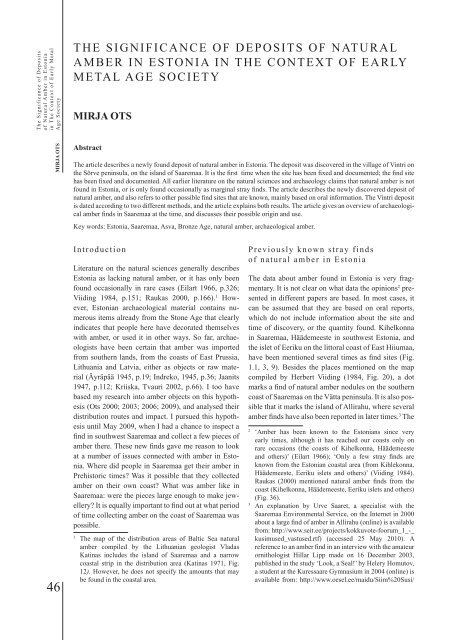BALTICA17 - KlaipÄdos universitetas
BALTICA17 - KlaipÄdos universitetas
BALTICA17 - KlaipÄdos universitetas
Create successful ePaper yourself
Turn your PDF publications into a flip-book with our unique Google optimized e-Paper software.
The Significance of Deposits<br />
of Natural Amber in Estonia<br />
in The Context of Early Metal<br />
Age Society<br />
THE SIGNIFICANCE OF DEPOSITS OF NATURAL<br />
AMBER IN ESTONIA IN THE CONTEXT OF EARLY<br />
METAL AGE SOCIETY<br />
MIRJA OTS<br />
MIRJA OTS<br />
Abstract<br />
The article describes a newly found deposit of natural amber in Estonia. The deposit was discovered in the village of Vintri on<br />
the Sõrve peninsula, on the island of Saaremaa. It is the first time when the site has been fixed and documented; the find site<br />
has been fixed and documented. All earlier literature on the natural sciences and archaeology claims that natural amber is not<br />
found in Estonia, or is only found occasionally as marginal stray finds. The article describes the newly discovered deposit of<br />
natural amber, and also refers to other possible find sites that are known, mainly based on oral information. The Vintri deposit<br />
is dated according to two different methods, and the article explains both results. The article gives an overview of archaeological<br />
amber finds in Saaremaa at the time, and discusses their possible origin and use.<br />
Key words: Estonia, Saaremaa, Asva, Bronze Age, natural amber, archaeological amber.<br />
46<br />
Introduction<br />
Literature on the natural sciences generally describes<br />
Estonia as lacking natural amber, or it has only been<br />
found occasionally in rare cases (Eilart 1966, p.326;<br />
Viiding 1984, p.151; Raukas 2000, p.166). 1 However,<br />
Estonian archaeological material contains numerous<br />
items already from the Stone Age that clearly<br />
indicates that people here have decorated themselves<br />
with amber, or used it in other ways. So far, archaeologists<br />
have been certain that amber was imported<br />
from southern lands, from the coasts of East Prussia,<br />
Lithuania and Latvia, either as objects or raw material<br />
(Äyräpää 1945, p.19; Indreko, 1945, p.36; Jaanits<br />
1947, p.112; Kriiska, Tvauri 2002, p.66). I too have<br />
based my research into amber objects on this hypothesis<br />
(Ots 2000; 2003; 2006; 2009), and analysed their<br />
distribution routes and impact. I pursued this hypothesis<br />
until May 2009, when I had a chance to inspect a<br />
find in southwest Saaremaa and collect a few pieces of<br />
amber there. These new finds gave me reason to look<br />
at a number of issues connected with amber in Estonia.<br />
Where did people in Saaremaa get their amber in<br />
Prehistoric times? Was it possible that they collected<br />
amber on their own coast? What was amber like in<br />
Saaremaa: were the pieces large enough to make jewellery?<br />
It is equally important to find out at what period<br />
of time collecting amber on the coast of Saaremaa was<br />
possible.<br />
1<br />
The map of the distribution areas of Baltic Sea natural<br />
amber compiled by the Lithuanian geologist Vladas<br />
Katinas includes the island of Saaremaa and a narrow<br />
coastal strip in the distribution area (Katinas 1971, Fig.<br />
12). However, he does not specify the amounts that may<br />
be found in the coastal area.<br />
Previously known stray finds<br />
of natural amber in Estonia<br />
The data about amber found in Estonia is very fragmentary.<br />
It is not clear on what data the opinions 2 presented<br />
in different papers are based. In most cases, it<br />
can be assumed that they are based on oral reports,<br />
which do not include information about the site and<br />
time of discovery, or the quantity found. Kihelkonna<br />
in Saaremaa, Häädemeeste in southwest Estonia, and<br />
the islet of Eeriku on the littoral coast of East Hiiumaa,<br />
have been mentioned several times as find sites (Fig.<br />
1.1, 3, 9). Besides the places mentioned on the map<br />
compiled by Herbert Viiding (1984, Fig. 20), a dot<br />
marks a find of natural amber nodules on the southern<br />
coast of Saaremaa on the Vätta peninsula. It is also possible<br />
that it marks the island of Allirahu, where several<br />
amber finds have also been reported in later times. 3 The<br />
2<br />
‘Amber has been known to the Estonians since very<br />
early times, although it has reached our coasts only on<br />
rare occasions (the coasts of Kihelkonna, Häädemeeste<br />
and others)’ (Eilart 1966); ‘Only a few stray finds are<br />
known from the Estonian coastal area (from Kihlekonna,<br />
Häädemeeste, Eeriku islets and others)’ (Viiding 1984).<br />
Raukas (2000) mentioned natural amber finds from the<br />
coast (Kihelkonna, Häädemeeste, Eeriku islets and others)<br />
(Fig. 36).<br />
3<br />
An explanation by Urve Saaret, a specialist with the<br />
Saaremaa Environmental Service, on the Internet in 2000<br />
about a large find of amber in Allirahu (online) is available<br />
from: http://www.seit.ee/projects/kokkuvote-foorum_1_-_<br />
kusimused_vastused.rtf) (accessed 25 May 2010). A<br />
reference to an amber find in an interview with the amateur<br />
ornithologist Hillar Lipp made on 16 December 2003,<br />
published in the study ‘Look, a Seal!’ by Helery Homutov,<br />
a student at the Kuressaare Gymnasium in 2004 (online) is<br />
available from: http://www.oesel.ee/maidu/Siim%20Susi/

















